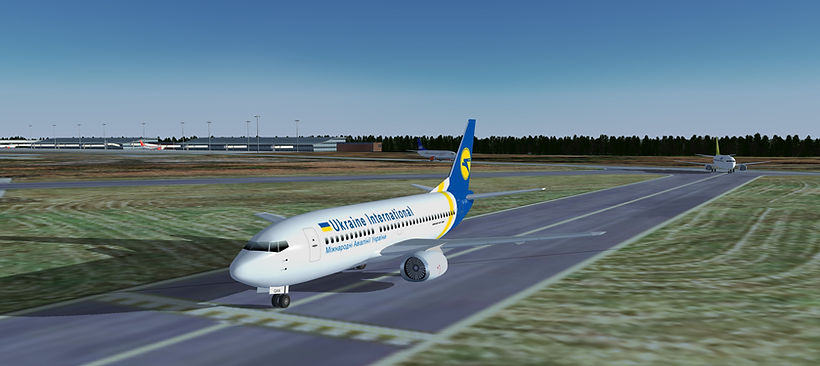eCoach 3D TWR
All variants of the eCoach ATC simulator can be delivered with simulator tower cabins. The choice of technology for out-of-the-tower-view is the choice of the customer from large cylindrical tower cabins using multiple projectors, through multiple LCD monitors in portrait mode, to a single LCD monitor on a laptop showing the same view.

Visualization Technologies
Today there are multiple technologies available for implementing out-of-the-tower-view for ATC simulator tower cabins. The two main technologies are:
-
LCD monitors
-
Projectors
LCD Monitors
LCD monitors comes in various sizes from small 15 inches up to more than 100 inches. Typical resolutions are HD (1920x1080 pixels) up to 8k (7680x4320 pixels). Best value for money is typically 55-85 inch monitors with 4k (3840x2160 pixels) resolution. These monitors when delivered with narrow bezels installed in portrait mode provides knife sharp visualization even in light conditions. For small and medium size tower cabins, landscape mode installation can be used, but for larger tower cabins portraint mode is used to provide better vertical field of view. Horizontal view can be up to 360 degrees. Below is an example landscape mode installation and a portrait mode installation.


Projectors
Another commonly used technology is projectors. Simulator tower cabins using projectors are typically for larger tower cabins with multiple working positions and up to 360 degrees horizontal view. Both front projection and backlight projection can be used. Backlight projection will require more space for installation of the solution. Below is two figures showing examples of front projection on a cylindrical wall and a wall formed by flat segment arranged in a cirle.


Flat screen
Using flat screens for simulator is the easiest projector installation. Todays projectors have many adjustments which makes it easy to create a seamless picture where the image from each projector is put next to each other with pixel accuracy.
Curved screen picture correction
The cylindrical wall requires a bit more work to create a seamless picture with up to 360 degrees of horizontal field of view. The eCoach 3D TWR software has built features for warping and edgeblending to create the perfect 360 degrees out-of-the-tower-view picture for projectors.

Warping
Warping is about transforming a picture or video from one type presentation to another. A projector is typically designed to display an image on a flat screen. If the same uncorrected picture is displayed on a curved screen, the picture will be distorted and look oval. The eCoach 3D TWR software contains warping algorithms and adjustments to correctly transform and display a standard projector picture ment for a flat screen, on a curved screen. With warping built into the eCoach software there is no need for warping in projectors or extra software to handle this.

Edgeblending
Edge blending is a technique to create a seamless picture using multiple projectors to blend into each other. Each projector displays a picture which is larger that it's main area (light pink), creating an overlap area with the neighbour projector. In the overlap area (dark pink). The picture will gradually fade out towards the neighbour projector. Using this technique, it's possible to create a seamless 360 degree picture. Edge blending is integrated into the eCoach 3D TWR software so there is no need for edge blending support in projectors or extra software..
Working positions
eCoach 3D TWR provides 3D visualisation of the environment on and around an airport and advanced ground simulations for aircraft and vehicles. Simulator pilot working positions can be fitted with an extra touch display to control aircraft and vehicles on the ground.

The user interface (UI) has been specially made for ease of use to increase pseudo pilot efficiency both in the air and on the ground. Aircraft can fly fully automated according to flight plan or can be hand flown using a graphical user interface or - if the user prefers - using keyboard with speed keys.
A simulation can contain many elements subject to pilot control, like:
-
Airport lighting
-
Weather
-
Parking, pushback, and taxiing
-
Emergency situations
Airport
An important aspect of the 3D tower simulation is a good model of the airport for the tower simulation. eCoach 3D Tower uses several sources to build a realistic airport model containing runways, taxiways, aprons, parking areas, buildings, signs, marking, airport lighting, roads, etc.
Terrain
The terrain model uses information about terrain levels and type of vegetation. To increase realism and visual recognition, the terrain model can be covered by orthophotos from aerial or satellite photography. Other types of objects may also use photos to provide a close to reality look.
Aircraft, vehicles and liveries
eCoach 3D Twr contains a lot of aircraft models with different liveries for various airlines. New aircraft and vehicle models and liveries can be added to the system as required.

Time, season and weather
The eCoach 3D TWR simulator emulates various types of environment data.
Time of day (sun and moon)

Wind

Time of year (season)

Clouds, precipitation and fog

Binoculars
The 3D Twr also contains a binoculars which are at the disposal of the controllers. Binoculars direction and zoom can be controlled by 3D space mouse or keyboard. For easy operation, the controller can also choose target to view on the radar display.


